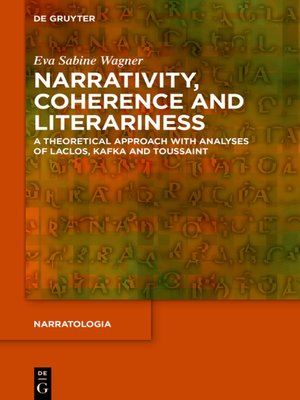Narrativity, Coherence and Literariness
ebook ∣ A Theoretical Approach with Analyses of Laclos, Kafka and Toussaint · Narratologia
By Eva Sabine Wagner

Sign up to save your library
With an OverDrive account, you can save your favorite libraries for at-a-glance information about availability. Find out more about OverDrive accounts.
Find this title in Libby, the library reading app by OverDrive.



Search for a digital library with this title
Title found at these libraries:
| Library Name | Distance |
|---|---|
| Loading... |
The search for the defining qualities of narrative has produced an expansive range of definitions which, largely unconnected with each other, obscure the notion of "narrativity" rather than clarifying it.
The first part of this study remedies this shortcoming by developing a graded macro model of narrativity which serves three aims. Firstly, it provides a structured overview of the field of narrative elements and processes. Secondly, it facilitates the classification of narratological approaches by locating them on different stages of narrativity. Finally, it focuses attention on narrative dynamics as interpretative processes by which readers seek to produce narrative coherence.
The second part of this study identifies three different narrative dynamics which characterise Laclos's "Dangerous Connections," Kafka's "Castle" and Toussaint's novels. Wagner bases her analyses of these dynamics not only on the texts themselves but also on the ways in which literary scholars imbue the texts with narrative coherence.
This book provides a long overdue systematisation of the jumbled field of theories of narrativity and opens new perspectives on the difficult relationship between narrative theory and interpretation.
The first part of this study remedies this shortcoming by developing a graded macro model of narrativity which serves three aims. Firstly, it provides a structured overview of the field of narrative elements and processes. Secondly, it facilitates the classification of narratological approaches by locating them on different stages of narrativity. Finally, it focuses attention on narrative dynamics as interpretative processes by which readers seek to produce narrative coherence.
The second part of this study identifies three different narrative dynamics which characterise Laclos's "Dangerous Connections," Kafka's "Castle" and Toussaint's novels. Wagner bases her analyses of these dynamics not only on the texts themselves but also on the ways in which literary scholars imbue the texts with narrative coherence.
This book provides a long overdue systematisation of the jumbled field of theories of narrativity and opens new perspectives on the difficult relationship between narrative theory and interpretation.






